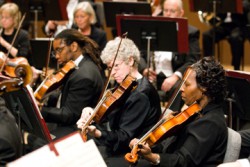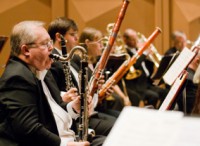Veteran S.C. Phil horn player Cyndi Williams answers the ages-old question: “So, what’s a philharmonic?”
As a member of the South Carolina Philharmonic, invariably, I am asked to explain the difference between a “symphony orchestra” and a “philharmonic orchestra.” I hope this will clear things up a bit.
Remember when your brain exploded after your math teacher told you, “Every square is a rectangle, but not every rectangle is a square!” in fourth grade? It’s kind of like that. Every symphony is an orchestra, but not every orchestra is a symphony. Likewise, every philharmonic is a symphony, but not every symphony is a philharmonic.
Okay, let’s break this down!

S.C. Phil violists focus intently on the music during a performance. The S.C. Phil is a symphony orchestra, but used to offer a chamber orchestra as well.
“Orchestra” is a broad term for any ensemble featuring a large group of strings. Two basic orchestras exist – chamber orchestras (small) and symphony orchestras (big). Chamber orchestras employ about 50 or fewer musicians. As the name suggests, they play “chamber music” – written for private halls, aristocratic parlors, and glitzy palace chambers. Of course, contemporary composers still write chamber music, but the style peaked during the 17th and 18th centuries with composers like Haydn, Mozart, and Vivaldi.

Members of the S.C. Phil’s woodwind and brass sections in action. Symphony orchestras, like the S.C. Phil, can use 100 players or more to play one musical work.
On the flip side, a symphony orchestra can boast more than 100 players, divided into strings, woodwinds, brass, and percussion. As that name suggests, they play “symphonies” – large pieces that usually require 18 to 25 different instruments. (Think of the composers of the 1800’s: Beethoven, Brahms, Wagner, etc.)
Essentially, if an orchestra is big enough to play a symphony, it’s a symphony orchestra.
Simple enough? Okay, next point. You might want to sit down.
A symphony orchestra and a philharmonic are the same thing – sort of. They’re the same size and they play the same kind of music. The two terms exist to help us tell different ensembles apart, especially in cities that boast multiple groups. They’re the same kind of orchestra, but they have different names so you don’t confuse them. The divide between symphony-philharmonic is just a matter of identity.
And that’s what makes them different. “Symphony orchestra” is a generic term, whereas “philharmonic orchestra” is always part of a proper name. So, you can call every philharmonic a symphony, but you can’t call every symphony a philharmonic – even though they’re talking about the same thing.
And as for “Pops?” That just means the orchestra isn’t afraid to let its hair down and play show tunes.
